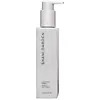What's inside
What's inside
 Key Ingredients
Key Ingredients

 Benefits
Benefits

 Concerns
Concerns

 Ingredients Side-by-side
Ingredients Side-by-side

Water
Skin ConditioningSodium C14-16 Olefin Sulfonate
CleansingPEG-16 Macadamia Glycerides
EmollientCaprylyl/Capryl Glucoside
CleansingGlycerin
HumectantHydroxypropyl Methylcellulose
Emulsion StabilisingSodium Cocoamphoacetate
CleansingPropanediol
SolventSodium Hyaluronate
HumectantCichorium Intybus Leaf Extract
MaskingAvena Sativa Kernel Extract
AbrasiveOlea Europaea Leaf Extract
PerfumingCocamidopropyl Hydroxysultaine
CleansingSodium Chloride
MaskingXanthan Gum
EmulsifyingPhenethyl Alcohol
MaskingPhenoxyethanol
PreservativeEthylhexylglycerin
Skin ConditioningButylene Glycol
HumectantCitric Acid
BufferingSodium Hydroxide
BufferingHexylene Glycol
EmulsifyingCaprylyl Glycol
EmollientWater, Sodium C14-16 Olefin Sulfonate, PEG-16 Macadamia Glycerides, Caprylyl/Capryl Glucoside, Glycerin, Hydroxypropyl Methylcellulose, Sodium Cocoamphoacetate, Propanediol, Sodium Hyaluronate, Cichorium Intybus Leaf Extract, Avena Sativa Kernel Extract, Olea Europaea Leaf Extract, Cocamidopropyl Hydroxysultaine, Sodium Chloride, Xanthan Gum, Phenethyl Alcohol, Phenoxyethanol, Ethylhexylglycerin, Butylene Glycol, Citric Acid, Sodium Hydroxide, Hexylene Glycol, Caprylyl Glycol
Sodium Myristoyl Glutamate
CleansingSodium Lauroyl Glutamate
Talc
AbrasiveZea Mays Starch
AbsorbentHydroxypropyl Starch
Kaolin
AbrasiveAluminum Silicate
AbrasiveDisodium Lauryl Sulfosuccinate
CleansingMicrocrystalline Cellulose
AbsorbentCarrageenan
Water
Skin ConditioningSerica Powder
Skin ConditioningButylene Glycol
HumectantAcetyl Glucosamine
Skin ConditioningAlcohol
AntimicrobialLactic Acid
BufferingCitric Acid
BufferingDipotassium Glycyrrhizate
HumectantQuillaja Saponaria Bark Extract
CleansingHydrolyzed Silk
HumectantPanax Ginseng Root Extract
EmollientPerilla Ocymoides Leaf Extract
TonicProtease
ExfoliatingLipase
Skin ConditioningSodium Benzoate
MaskingChlorphenesin
AntimicrobialPhenoxyethanol
PreservativeCI 61570
Cosmetic ColorantSodium Myristoyl Glutamate, Sodium Lauroyl Glutamate, Talc, Zea Mays Starch, Hydroxypropyl Starch, Kaolin, Aluminum Silicate, Disodium Lauryl Sulfosuccinate, Microcrystalline Cellulose, Carrageenan, Water, Serica Powder, Butylene Glycol, Acetyl Glucosamine, Alcohol, Lactic Acid, Citric Acid, Dipotassium Glycyrrhizate, Quillaja Saponaria Bark Extract, Hydrolyzed Silk, Panax Ginseng Root Extract, Perilla Ocymoides Leaf Extract, Protease, Lipase, Sodium Benzoate, Chlorphenesin, Phenoxyethanol, CI 61570
Ingredients Explained
These ingredients are found in both products.
Ingredients higher up in an ingredient list are typically present in a larger amount.
Butylene Glycol (or BG) is used within cosmetic products for a few different reasons:
Overall, Butylene Glycol is a safe and well-rounded ingredient that works well with other ingredients.
Though this ingredient works well with most skin types, some people with sensitive skin may experience a reaction such as allergic rashes, closed comedones, or itchiness.
Learn more about Butylene GlycolCitric Acid is an alpha hydroxy acid (AHA) naturally found in citrus fruits like oranges, lemons, and limes.
Like other AHAs, citric acid can exfoliate skin by breaking down the bonds that hold dead skin cells together. This helps reveal smoother and brighter skin underneath.
However, this exfoliating effect only happens at high concentrations (20%) which can be hard to find in cosmetic products.
Due to this, citric acid is usually included in small amounts as a pH adjuster. This helps keep products slightly more acidic and compatible with skin's natural pH.
In skincare formulas, citric acid can:
While it can provide some skin benefits, research shows lactic acid and glycolic acid are generally more effective and less irritating exfoliants.
Most citric acid used in skincare today is made by fermenting sugars (usually from molasses). This synthetic version is identical to the natural citrus form but easier to stabilize and use in formulations.
Read more about some other popular AHA's here:
Learn more about Citric AcidPhenoxyethanol is a preservative that has germicide, antimicrobial, and aromatic properties. Studies show that phenoxyethanol can prevent microbial growth. By itself, it has a scent that is similar to that of a rose.
It's often used in formulations along with Caprylyl Glycol to preserve the shelf life of products.
Water. It's the most common cosmetic ingredient of all. You'll usually see it at the top of ingredient lists, meaning that it makes up the largest part of the product.
So why is it so popular? Water most often acts as a solvent - this means that it helps dissolve other ingredients into the formulation.
You'll also recognize water as that liquid we all need to stay alive. If you see this, drink a glass of water. Stay hydrated!
Learn more about Water